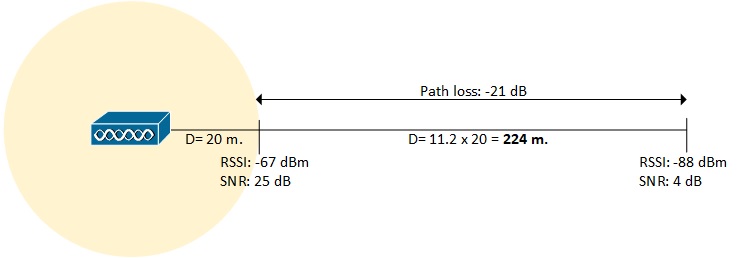No, disabling the lower data rates won’t reduce your cell size!
There is a consensus amongst Wi-Fi engineers that the area covered by an Access Point (the “cell”) can be effectively reduced by disabling lower data rates from the rate set. The more data rates you disable from the lower end of the set, the more you “shrink” the cell, allowing for better channel reutilisation and increasing the overall capacity as a result.
However, this is not strictly true – you have to take into account the PLPC Header. Let’s take a closer look into this:
The PLPC Header is appended to the PSDU at the PLPC sublayer, and contains various elements to describe how to process the subsequent payload.

The PLPC Header is 40 bits long as depicted in the figure. The Rate field indicates the MCS rate at which the payload will be sent. the Length field indicates the duration of the PPDU, so any listening stations can adjust their NAV.
So what does the Header has to do with the cell size? here it is: part of the Header (the Signal Symbol, first 24 bits) is always sent at the lowest data rate: 6 Mbps with BPSK modulation, for 802.11a or 802.11g ERP-OFDM. No matter the lower data rates that you may disable, it is always 6 Mbps. This is per the 802.11 specification and cannot be changed:

Also, by the same specification, the Header can be decoded by any station as long as it is heard at least 4 dB above the noise floor.
Now the picture starts to unfold: the Header will be heard much further away than the cell edge, causing any station within its range and in the same channel to contend for the medium.
We can see the implications on a standard VoIP design with a cell edge of -67 dBm and a SNR of 25 dB (therefore assuming a noise floor of -92 dBm), and where all data rates below 12 Mbps have been disabled:

You can usually achieve this cell edge at 20 metres from the Access Point (depending on environmental conditions). But the distance at which the Header can be decoded stretches much more – up to 224 metres beyond the cell edge!
Conclusion
With the PLPC Header stretching distances longer than the cell size, it’s now evident that proper channel patterns are of the greatest importance if we want to avoid interference and wasting airtime. Distant stations that can decode the Header will reckon the channel as busy for the full duration of the frame, even if the subsequent payload cannot be decoded.
Removing the lower data rates has no effect on the distance at which the Header can be decoded. The only effects of this measure are:
- Force mobile clients to roam to a nearby Access Point when they cannot achieve the available data rates.
- Reduce airtime consumption by 802.11 control frames, by forcing stations in a BSS to use a higher minimum rate